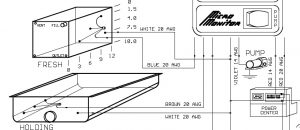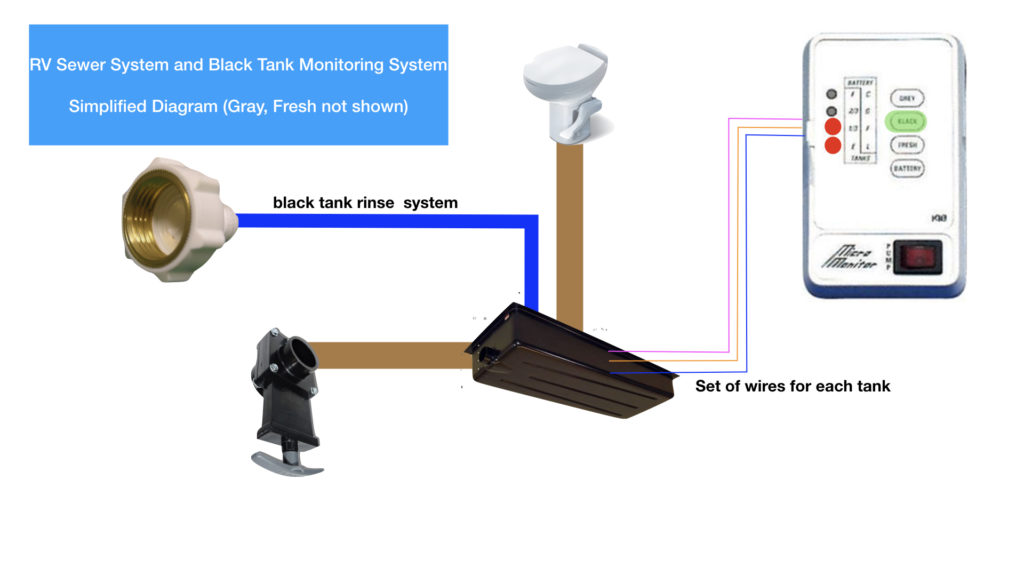The RV sewer system and holding tank wiring and plumbing are one of the most discussed and lamented systems on the RV.
Typical RV Sewer System with holding tank wiring Diagram
In the typical modern RV sewer system you really only have the toilet pipe going straight into a black tank. The black tank is piped to a drain valve that has the large blade. You can open and close the valve easily with the large pull tab. That valve then flows out the exit portal into a stinky slinky. In turn, the slinky is connected to an external receptacle. The receptacles is usually a plumbing fitting going into a septic tank or city sewer.
The holding tank monitor has probes at 1/3, 2/3, and full. These probes will then sense a water level at each probe. These probes are wired back to a monitor. This monitor will have a set of wires for each tank. The simple theory of operation is that water touching the probe will demonstrate a higher signal level that can be detected. This works somewhat in most tanks but the black. (See below for more)
Why do the blank tank monitors get stuck at certain levels?
We have yet another little mystery with Puma. The black water indicator is STUCK at 2/3 full and there is very little we can seem to do to get it unstuck. If you understand (read below) that the monitors are like little probes with a plus (+) and a minus (-) then that is step 1 to understanding. Step 2 is realizing that the black tank is the one tank where the water has debris of all yukky types in the tank.
So what happens is that the debris, whatever it is, clings to the probe ACROSS the plus-minus ( + – ) connection making the probe think the overall level of stuff is at that probe when in all actuality the true level is much lower.
Do black tank rinse systems improve the reliability of the black tank monitors
Our Open Range (we had after Puma) had a black tank rinse which should have helped the sticky probes, but I don’t think it did. With the black tanks we relied on the nose and the sound of the toilets.
What do the typical black tanks look like?
My first question is what do the black water holding tanks look like? I found a page that has many pictures of the black water holding tanks and I think this is probably very representative of what most black water or sewer holding tanks look like.
I found a very good selection of Black Water Holding Tanks from Camping World.
Walmart only had the portable RV holding tanks which is different from the rv sewer system we’re describing here.
Holding tank wiring and monitoring systems
On our PUMA, I can’t say for sure, but I’m pretty sure that the tank monitoring unit is from KIB and what I’m showing is an almost perfect copy of our unit :

I found the following wiring diagram on the kib web site. You can get a PDF, but I show just the section that shows the wiring of the black water (sewer) tank sensor system :

(I’m hoping you can blow it up by clicking on it) .
How a SIMPLE black tank monitoring system works
How the sensor system seems to work : It looks like this is as simple as a wiring system that has a ground and then three wires at different levels in the tank. When the “lovely goo” level raises in the tank, it contacts a wire and then reads a lower resistance than when the substance isn’t in contact with the wire. This seems notoriously unreliable. But now I have something I can work with to see if the sensor is just covered up or broken.
My observation is that as near as I can tell, the sensors not working well for the black water are a pretty common problem.
Alternative ways of sensing tank levels.
I also think there are other methods like capacitive sensing, RF sensing, ultrasonic sensing as well as the resistive. A quick search on the web yields several systems quite easily.
A possible method of making your tank easier for the gunk to slide out
One other thing we’re going to do is to start using a little water softener in our black tank. It doesn’t look harmful and it is supposed to make your tank ‘slickery’ which helps the debris sluice on out. This is called the geo method, or at least part of it for sure.
We don’t want to use many chemicals, but we thought water softener seems like a simple/good idea. This article isn’t about black water tank care, but just about simple facts about black water tanks. I have found that there just isn’t info ABOUT the tanks, but there is lots about caring for the tanks.
You can find lots more information about rv black water on my RV52 how to page. There is a ton of crap (ha ha – I mean information) on that page.
Since I’ve been a bit more on the monitoring/electronics side of the holding tanks, I thought I would put some Amazon listings that are relevant to monitoring systems next.

Leave a Reply